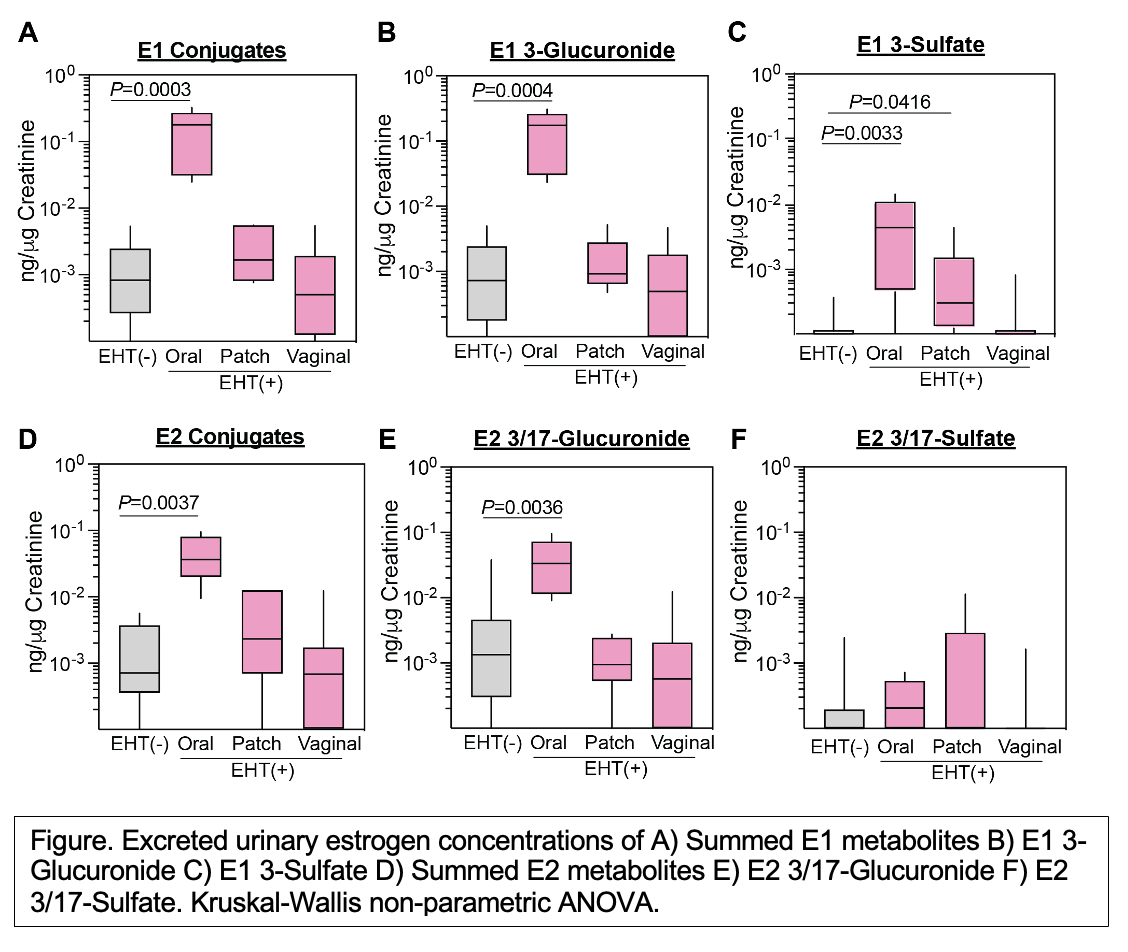Back
Poster, Podium & Video Sessions
Moderated Poster
MP38: Sexual Function/Dysfunction: Basic Research & Pathophysiology
MP38-05:Targeted Liquid Chromatography Mass Spectrometry Quantification f Excreted Urinary Estrogens among Postmenopausal Women Using Different Estrogen Hormone Therapy Modalities
Sunday, May 15, 2022
7:00 AM – 8:15 AM
Location: Room 222
Michael L. Neugent, Neha Hulyalkar, Richardson, TX, Vladimir Shulaev, Denton, TX, Philippe E. Zimmern, Dallas, TX, Nicole J. De Nisco*, Richardson, TX

Nicole De Nisco, PhD
Assistant Professor
University of Texas at Dallas
Poster Presenter(s)
Introduction: Estrogen hormone therapy (EHT) is commonly used among postmenopausal women to treat symptoms of menopause. EHT can be administered via multiple modalities including oral (oEHT), transdermal patch (pEHT), and vaginal (vEHT). To date, there is little quantitative literature comparing the modalities of EHT and their respective excreted metabolites. Quantifying excreted estrogens to assess EHT dosage, compliance, or metabolism can be challenging due to the chemical nature of estrogens and their metabolites. The goal of this work was to develop and implement a robust, sensitive liquid chromatography mass spectrometry (LC-MS)-based targeted assay for the detection of excreted urinary estrogen conjugates at the picomolar range using a minimal volume of urine.
Methods: We used a strictly curated, controlled cohort of postmenopausal women (n=50) who passed a set of exclusion criteria for an ongoing study of recurrent UTI (rUTI) but were not currently experiencing infection at the time of urine donation. Clean-catch mid-stream urine was collected, estrogens were extracted from urine via solid phase extraction, and analyzed by a sensitive, targeted LC-MS.
Results: In this study we generated a sensitive, targeted LC-MS assay for the quantification of urinary estrogen conjugates, included the sulfates and glucuronides of Estrone (E1) and 17ß-Estradiol (E2). Implementation of this assay on urine samples from a clinical cohort of postmenopausal women found that oEHT and pEHT modalities exhibited the highest levels of excreted urinary estrogen conjugates. Interestingly, we found that women using vEHT exhibited urinary estrogen concentrations that were not distinguishable from women who were not using EHT.
Conclusions: These data suggest that oEHT and pEHT modalities exhibit higher concentrations of excreted urinary estrogen conjugates, which may be a proxy biomarker for systemic estrogen concentration during EHT
Source of Funding: The Welch Foundation, The Foundation for Women’s Wellness, NIH grant 1R01DK131267-01, and The University of Texas at Dallas Startup funds to NJD, The Felicia and John Cain Distinguished Chair in Women’s Health to PZ

Methods: We used a strictly curated, controlled cohort of postmenopausal women (n=50) who passed a set of exclusion criteria for an ongoing study of recurrent UTI (rUTI) but were not currently experiencing infection at the time of urine donation. Clean-catch mid-stream urine was collected, estrogens were extracted from urine via solid phase extraction, and analyzed by a sensitive, targeted LC-MS.
Results: In this study we generated a sensitive, targeted LC-MS assay for the quantification of urinary estrogen conjugates, included the sulfates and glucuronides of Estrone (E1) and 17ß-Estradiol (E2). Implementation of this assay on urine samples from a clinical cohort of postmenopausal women found that oEHT and pEHT modalities exhibited the highest levels of excreted urinary estrogen conjugates. Interestingly, we found that women using vEHT exhibited urinary estrogen concentrations that were not distinguishable from women who were not using EHT.
Conclusions: These data suggest that oEHT and pEHT modalities exhibit higher concentrations of excreted urinary estrogen conjugates, which may be a proxy biomarker for systemic estrogen concentration during EHT
Source of Funding: The Welch Foundation, The Foundation for Women’s Wellness, NIH grant 1R01DK131267-01, and The University of Texas at Dallas Startup funds to NJD, The Felicia and John Cain Distinguished Chair in Women’s Health to PZ


.jpg)
.jpg)